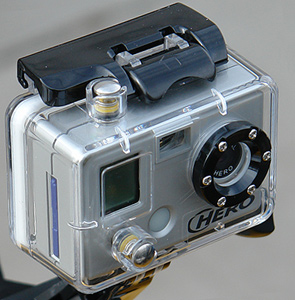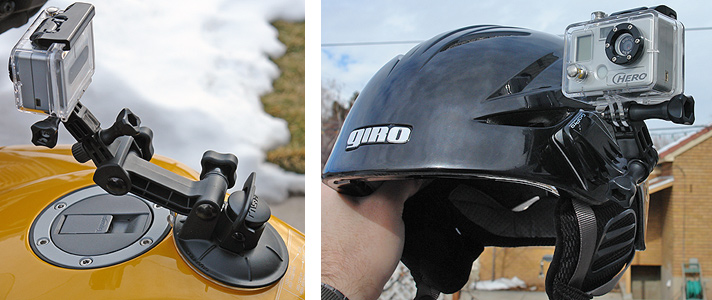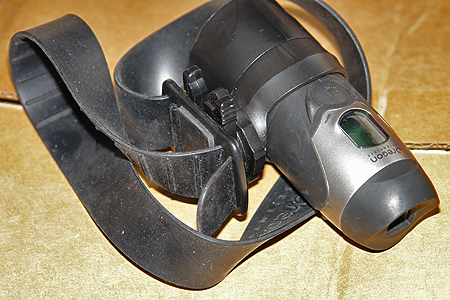The car Bibles product reviews: Wearable action / sports camcorders.
Product Reviews
'Wearable' action / sports camcorders
There's a new breed of camcorder coming to the market - self-contained flash memory camcorders. Two of them tout their product as 'sports' or 'action' camcorders. The idea is simple enough - a compact, self-contained unit with a lens, CCD, microphone, memory card slot, some batteries and a set of rudimentary controls. I review the two contenders here.
GoPro Hero Digital Sports Camcorder
Tested January 2008 
Website: www.goprocamera.com

Billed as a waterproof digital camera for sport, the Digital Hero was launched at the SEMA show in Vegas last in 2007. It comes in three flavours - wrist camera, helmet camera and motorsports camera. The three units are actually all the same - the difference is in the mounting kits that they come with. The wrist camera comes with a velcro wrist strap. The helmet cam comes with various helmet mounting options and the motorsports cam comes with a bunch of stick-on mounts and a suction cup mount. What differentiates the GoPro from the ATC-2K is the form factor (it looks like a mini digital camera) and the fact that it comes in a shockproof, bombproof, waterproof housing. To test it, I went skiing with it, and then used the suction cup mount to video footage from my motorbike. You can see samples of the bike test later in the review.
Higher resolution, more fps. One of the things I noted about the ATC-2K below is that the sensor is a 320x240 sensor that upscales to 640x480 for the video. The GoPro runs a 512x384 panel at 30fps so you get about 50% more resolution and double the framerate. Because of this, a 2Gb SD card will hold about 55 minutes of video with the GoPro compared to over an hour with the ATC-2K.
Playback, menus and transferring the data. The GoPro comes with a hybrid connection cable with an ultra mini proprietary plug on one end and a USB, audio and video connector on the other end. Plug it in to a PC and it shows up as a removable disk drive full of AVI and JPG files. It's USB 1.0 so transferring the data takes a while. Plug it into an AV input on your TV and you get to see the results played back instantly. The on-screen menu is a little cumbersome, as with the ATC-2K below, but it does a reasonable job given the camera only has two buttons.
The buttons are located on the front and the top of the camera. The front one is on/off and mode selection. The top one is shutter and mode entry. So to flip through the menu options on the built-in LCD screen, click the button on the front. To select an option, click the button on the top and so on. The LCD is actually upside down, which is a bit odd, but the camera was originally designed to be wrist-mounted, and once you understand that, it sort of makes sense. The various menu options allow you to output video at 50 or 60hz, NTSC or PAL, and to set up things like auto power off, remember previous shooting mode, and upside down mode. In upside down mode, you can mount the camera upside down and the video will be flipped so it's the right way up. Neat.
Mounting options and that case. There are a bazillion mounting options for the GoPro depending on the kit you buy. They also offer accessory kits for around $40 a piece which give you even more options. The Motorsports version I review here comes with a grab-bag of flat and curved mounting plates (for flat surfaces, or slightly curved surfaces like a helmet), thumbscrew connectors to join the various mounting arms together and a suction cup mount for window and car or bike bodywork. One thing to note. The supplied mounting plates come with double-sided 3M VHB tape. VHB means Very High Bond. Do not - I repeat do not stick one of these somewhere where you might regret it - like on to a painted surface. It will not come off without destroying the mounting surface. VHB tape is bloody strong and it's an inspired choice for a camera mount. For the trivia buff, VHB tape is 10 times stronger than rivets in a like-for-like bonding strength test. (Discovery channel clip about testing VHB tape). The clear plastic case that you fit the camera into looks quite well constructed too, with a lever-action clasp on top to hold the back plate shut, compressing a sealing o-ring to keep water and dirt out.

Stills, video and sound. The GoPro takes 3MP still photos - pretty reasonable ones - and it can be set to do single-shot, three-in-a-row, or time-lapse one shot every 5 seconds. Obviously it also shoots video with sound. There is a menu option on the camera to set the audio sensitivity of the microphone to high or low. In low mode, it's tuned to engine sounds. In high mode, it's less muffled and designed for less noisy environments. In my test, I forgot to set it to high mode when skiing, which made the sound very muffled. On the motorbike, in low mode, it picks up the sound of the engine beautifully. It's only marred by the fact that on my bike it also picked up a lot of electrical interference from the alternator or one of the spark plugs. It manifests itself as a constant buzzing on the soundtrack. Bummer. When the weather warms up, I'll try it again mounted with a little RF screen around the camera to try to isolate it from the electrical noise to see if I can get better results.
The video does suffer the same vertical 'wah wah' type effect as the ATC-2K below, but it's nowhere near as pronounced and it takes a good sized bump in the road to make it noticable. I think the extra framerate helps this out, plus the resulting video does give more of a sense of speed. This example shows some clips from my road test. The black thing on the left of the video is my GPS mount which was in the way.
Heed the battery warning! One of the slips of paper that comes with the GoPro, there's quite a strong recommendation that you don't use alkaline batteries in it. The current drain of the GoPro is a lot more than the ATC-2K below, because the CCD is larger, and in cold weather, alkaline batteries just don't cut it. I tested the GoPro with alkaline and the recommended Lithium batteries. On a 4°C (40°F) day in January, attached to my motorbike, the alkaline batteries died in 7 minutes. They went from 1.65v new, to 1.37v after 7 minutes. That's below the power threshold for the GoPro and it just shut down. Doing the same test with Lithium batteries revealed a voltage drop from 1.75v new to 1.66v after 50 minutes of filming. With the lithium batteries, 30 minutes of filming was done skiing in -3°C (28°F) temperatures. Okay so that's down there in terms of filming temperatures, but the GoPro is billed as a sports camcorder and it does lay claim to being useful for skiing and snowboarding. So my recommendation : Lithium batteries, or rechargeable NiMh (nickel metal hydride) batteries are what you want.
A couple of items missing from the manual. There are a couple of details missing from the instruction sheet which are worth knowing with the GoPro.
(1) Even if the camera is set to 'remember' the previous mode it was in, if you connect it to a PC via USB to pull the videos and photos off, the next time you turn the camera on it defaults to single image photo mode again. If you use this camera, you need to double-check the shooting mode after a USB connection.
(2) To connect via USB, plug the USB into the camera when it's turned on, then connect it to the PC. If you plug it in first and then turn it on, you'll get a generic device failure message and the camera won't be properly recognised.
These are minor irritations but nothing to cry about. Once you've come across these issues once, you tend to remember next time.
Conclusion : A worthy contender
In a like-for-like test, I'd have to go with the GoPro over the ATC-2K. I found it easier to use and a lot easier to line up when using a helmet mounting option. The video seems clearer, the sound is a little better and it takes 3MP stills too which is a bonus. The video still has distortion when used on a vibrating surface, like a motorbike, but I think that's an inherent issue with this type of device. Short of a vibration-isolating platform, or in-camera vibration cancelling, I'm not sure there's anything you can do about it. But compared to the ATC-2K, I found the effect much less pronounced in the GoPro.
ATC-2K / ATC2000 ActionCam
Tested October 2007 
Website: www.oregonscientific.com

Second up is the ATC-2K; a followon to the ATC1000 - also a 'wearable' sports camcorder. Unlike the GoPro, the ATC-2K has a tube form factor with the lens at the front and the batteries and connectors at the back, with the LCD and buttons on the top. To test it, I attached it to a friend's motorbike handlebars using the supplied mounting kit, and got him to shoot some video of me during a motorcycle trip in late 2007. You can see the video later in the review. Like the GoPro, the ATC-2K has a small amount of memory built-in, but it's so small you'll want the 2Gb SD card again. The camera comes with a rubber helmet strap, a quick-release bracket, a handlebar clamp, a USB cable and an A/V cable. The helmet strap allows a lot of wobble once the camera is mounted, because there's no permanent mount like there is with the GoPro. Plus the camera is quite hefty so once it's perched in it's quick release bracket, there's a lot of mass to wobble about and stress the rubber strap. The controls are pretty simple again - on/off and record/stop. The rear cap is a waterproof, o-ring sealed affair that you screw off to get at the batteries, SD card slot, USB and A/V connectors. The spec for this camera is video at 640x480 but the results look like they're 320x240 upscaled in the camera. An examination of the resulting video files shows they're running at 15 frames per second which is OK, but not stellar. The lower sized LCD panel and lower framerate do mean you can get more video on to a 2Gb card than the GoPro though.
Playback and connectivity. The easiest way to get the videos out of the ATC-2K is to attach it to a PC using the supplied USB cable. Once connected, it shows up as a removable disk drive and you can just copy the videos over to the PC and play them back. Unlike the GoPro, it doesn't seem as sensitive to the connection and power on/off order. There is an option to use an A/V cable to connect it to a TV for direct playback. This works reasonably well but the on-screen navigation is again a little cumbersome and basic. But then again, the camera only has three buttons on it so there's a limit to how much functionality you can achieve with those limits.
No viewfinder. As with the GoPro, there is no screen to preview what the camera is looking at. The real problem here is that there's not even a viewfinder to give you some idea. This leads to a certain amount of guesswork when mounting the camera because you're never entirely sure what it's looking at. For a motorbike or car, it's not so difficult - point it level and straight and you're pretty much set. For using it on a helmet though, the results are considerably harder to predict. I did shoot some skiing footage in January 2008 but after three attempts, each time I ended up shooting the sky or the tip of one of my skis because I just couldn't get the alignment right. So that's a definite drawback for the ATC-2K.

Recessed lens - hard to keep clean. In the ATC-2K, the lens is recessed quite noticably into the unit itself. When skiing, this recess filled with snow very quickly, but I didn't realise until I got home and played back an hour of fog. When using it on the motorbike, we got dead bugs stuck in the recess frequently and because of the design, it's bloody difficult to get them out and to clean the lens cover.
Can you shout that again? I have a real issue with the audio on the ATC-2K - it's almost none-existant. The example video here has a nice engine and wind sound to it, but when you take the ATC-2K in to a quiet environment, like skiing, or filming from inside a vehicle, the audio is imperceptible on playback. I tried videoing a narrated commute home one day, and all I got was the rattling panel in the front of my dashboard. My entire narration was there, but I had to crank the volume up to 11 to hear it, by which point, the rattling panel sound was like Concorde crashing into my house. Unlike the GoPro, there is no audio sensitivity option so it's loud, or nothing. On the plus side, the ATC-2K doesn't seem to be as sensitive to electrical interference noise, so my noisy alternator might not be a problem with this camera.
Video distortion. Finally, and perhaps most annoyingly, he ATC-2K has no vibration or shockproofing. When used on the motorbike which had high frequency vibration coming through the handlebars, the ATC-2K suffered from a terrible vertical 'wah wah' picture distortion. You can see it in the example video. The picture constantly stretches and squashes vertically, and it seems to lose framerate too. You'd never know it from the video, but we were doing well over 80mph on that road yet on the video, with the missing frames and picture distortion, it looks like we were out for a 30mph afternoon ride. The GoPro has the same issue but it's markedly less apparent. This is the sample ATC-2K video:
Better battery performance. One area the ATC-2K does win out over the GoPro is battery performance. Because the power requirements for the smaller LCD panel are less, it does better in cold weather shooting. In my test, with alkaline batteries, the ATC-2K got about 18 minutes of shooting to the GoPro's 7 minutes. The voltage drop was about the same: 1.65v down to 1.35v in 4°C (40°F) weather. Again, once replaced with lithium batteries, you'd probably run out of memory card space before battery life became an issue.
Conclusion - the not-so-action cam.
I've given this product two to three stars because if you use it for basic videography, it's not bad. However, if you use it for what it's advertised for - sports and action videography, it's not really up to snuff. The image distortion in motorsports is really irritating and the recessed lens design is just plain bad. The audio pickup is dodgy unless you're shouting or videoing something suitably noisy. I suspect these wrinkles will be ironed out in due course with later designs, but for now, I'd give this a miss.
Comparison
| GoPro Hero | ATC-2K | |
|---|---|---|
| Video resolution | 512x384 native 30fps native |
320x240 upscaled to 640x480 15fps with frame-doubling to 30fps |
| Form factor | Rectangular mini cam | Tubular 'bullet' |
| Memory card | Up to 2Gb SD card | Up to 2Gb SD card |
| Video in minutes | 56 mins / 2Gb | 70 mins / 2Gb |
| Waterproof | 30m / 100ft | 3m / 10ft |
| Shockproof? | Yes | Yes |
| Batteries | 2 x AAA | 2 x AA |
| Price when tested | US$139 / US$169 / US$179 depending on version |
US$129 with free 2Gb SD card |
